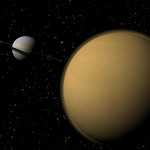Extraterrestrial life in the new IB guide
Sunday 21 September 2014
 When I began teaching in 1991 I never dreamed that one day I'd be teaching about extraterrestrial life in a Biology lesson. I'm always keen to bring new research into lessons and I like looking for ways to catch students' interest in the dryer parts of the course. Comparing the thermal properties of methane and water in the Molecular Biology topic (2.2) is a case in point. Looking up values in a data book and comparing numbers of specific heat capacity or boiling points is pretty dull. (sorry Chemists)
When I began teaching in 1991 I never dreamed that one day I'd be teaching about extraterrestrial life in a Biology lesson. I'm always keen to bring new research into lessons and I like looking for ways to catch students' interest in the dryer parts of the course. Comparing the thermal properties of methane and water in the Molecular Biology topic (2.2) is a case in point. Looking up values in a data book and comparing numbers of specific heat capacity or boiling points is pretty dull. (sorry Chemists)
New data from the Cassini spacecraft show hydrogen is disappearing near Titan's surface. There are lakes of methane, and it may even rain methane. Scientists have not been able to find acetylene, an organic molecule that should be pretty abundant in the moon's thick atmosphere. This evidence fits very nicely with a theory from NASA astrobiologist Chris McKay, that microbial life on Titan could breathe hydrogen and eat acetylene, producing methane as a result.
This fits perfectly with the requirements for students to compare the thermal properties of methane and water in topic 2.2. Water is present on Titan but it forms brittle rocks as hard as granite, the temperature is around -180°C and the atmospheric pressure is 1.5 times that of Earth. Methane melt at -180°C and boils on earth at about -160°C and so is likely to exist as a liquid and a gas. (Neatly avoiding any Physics calculations). Add a short video clip showing a NASA astrobiologist excited about his discovery and a page of extra reading about life on Titan and suddenly even a biologist is interested to know what the boiling point of methane is, and if it will be such a good solvent as water in an alien cell's cytoplasm.
See activity 3 in the new lesson about the properties of water

